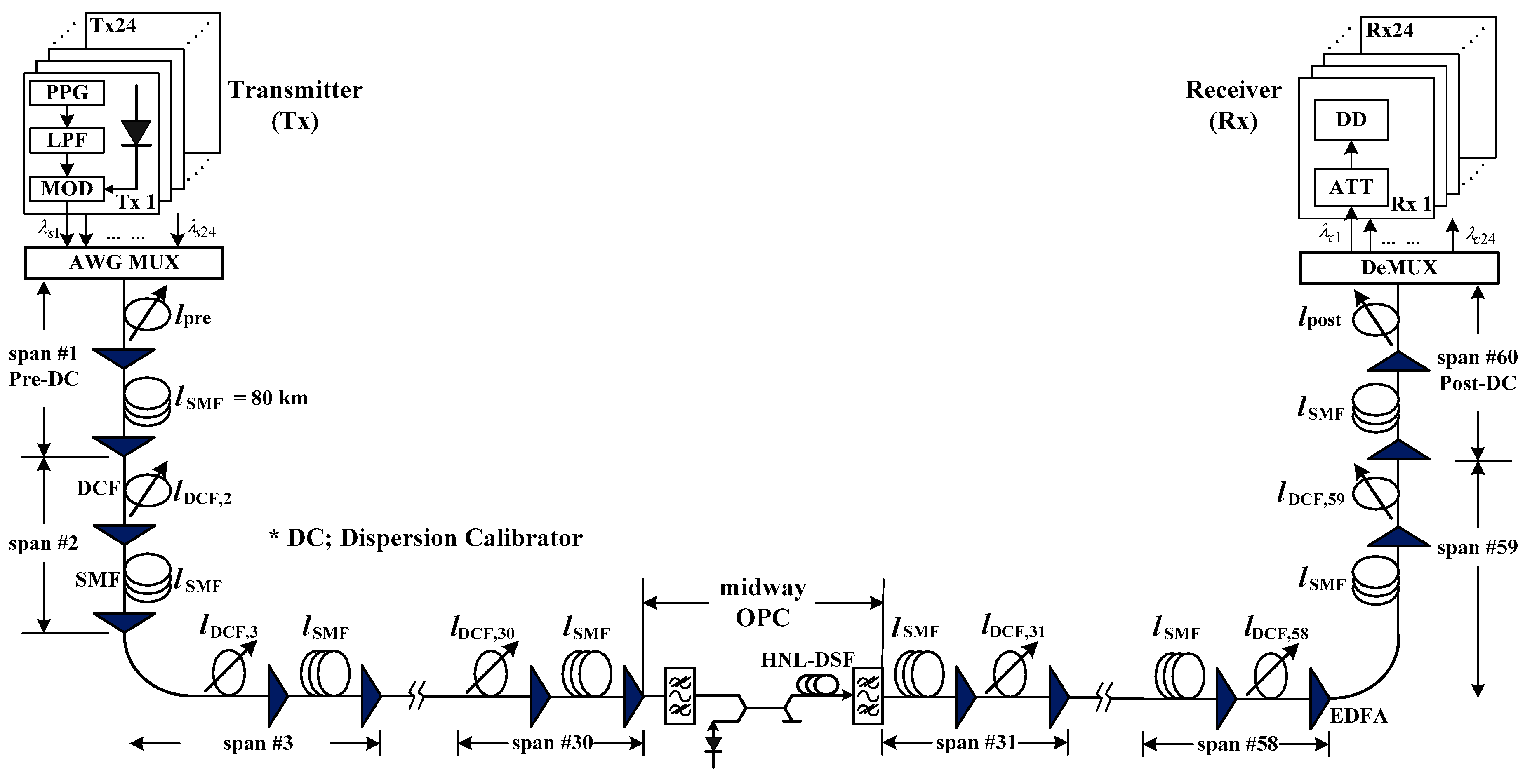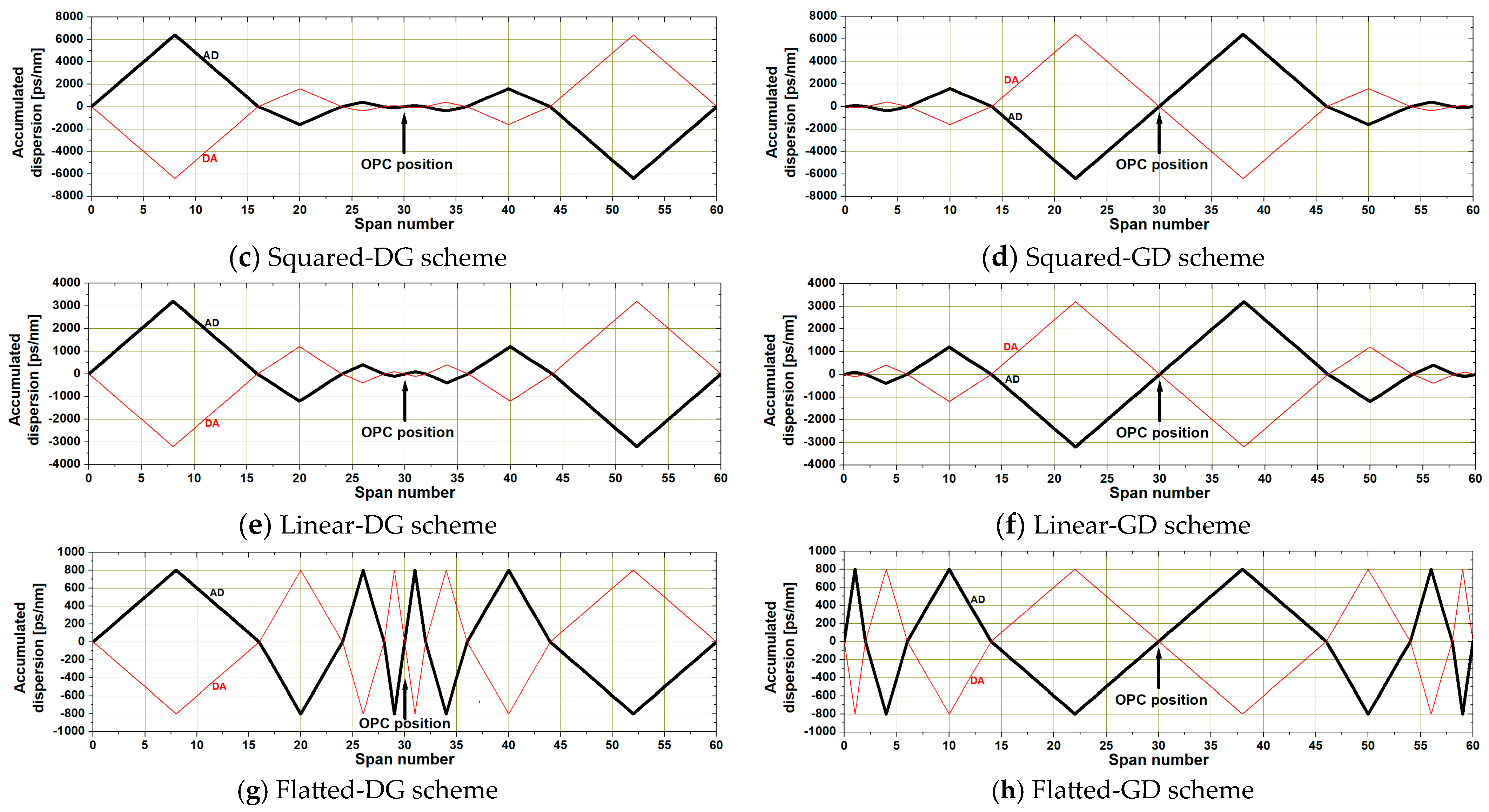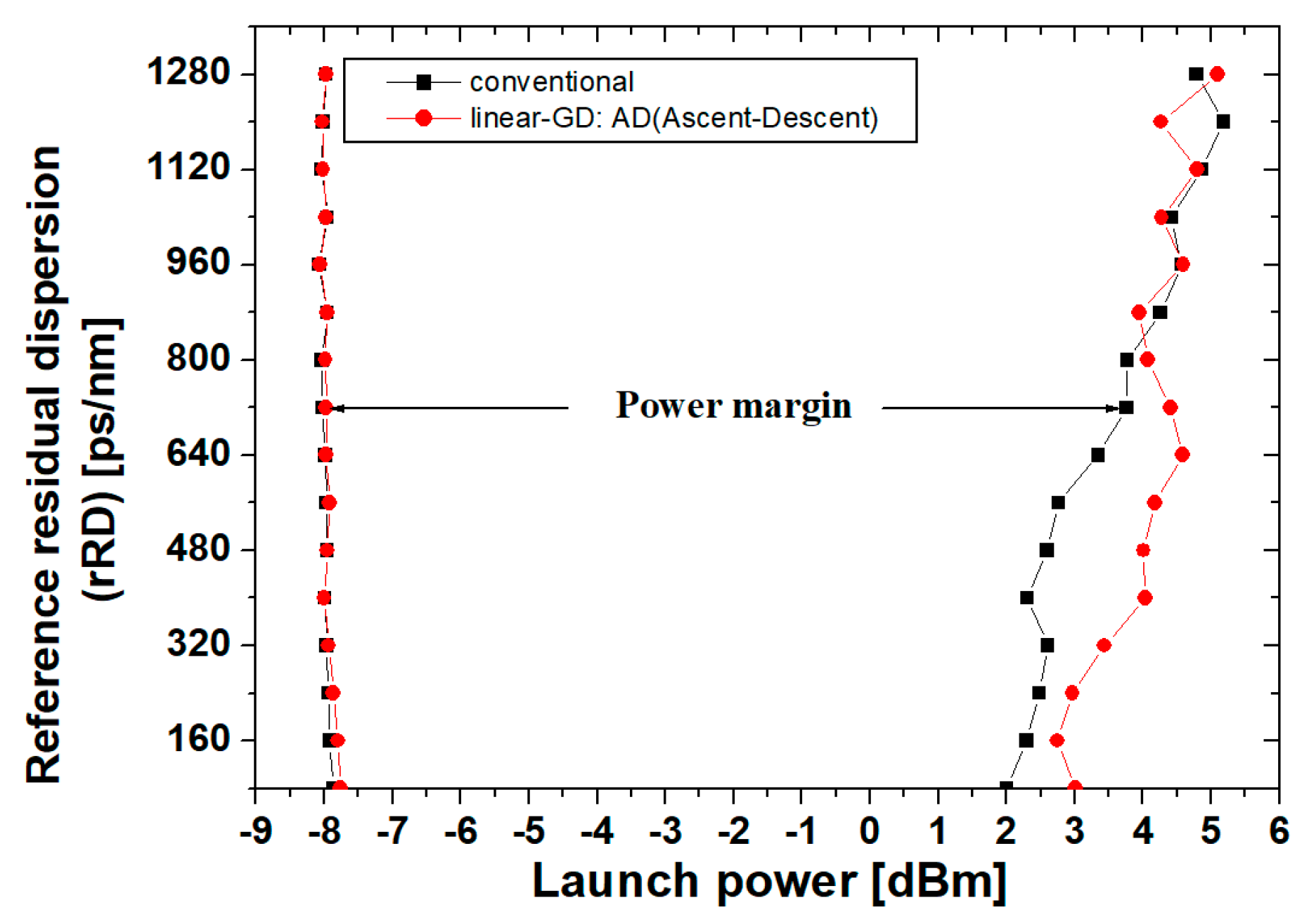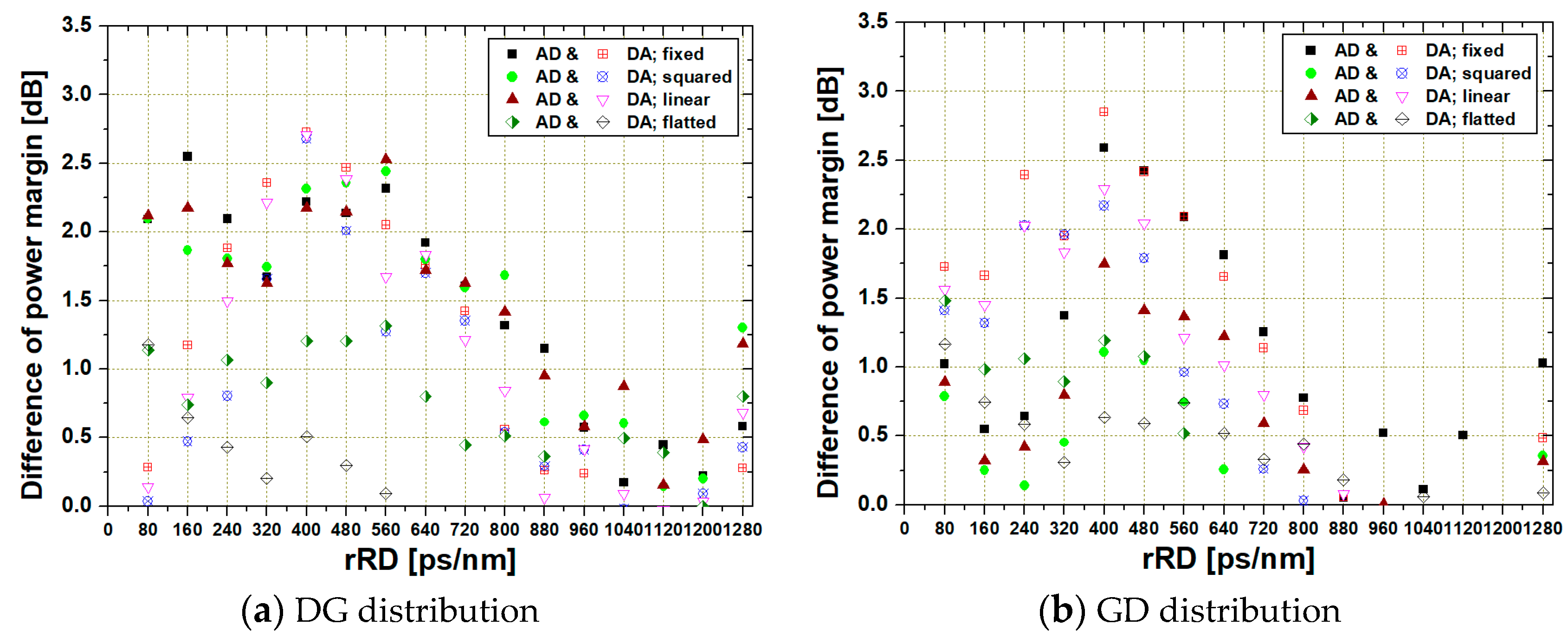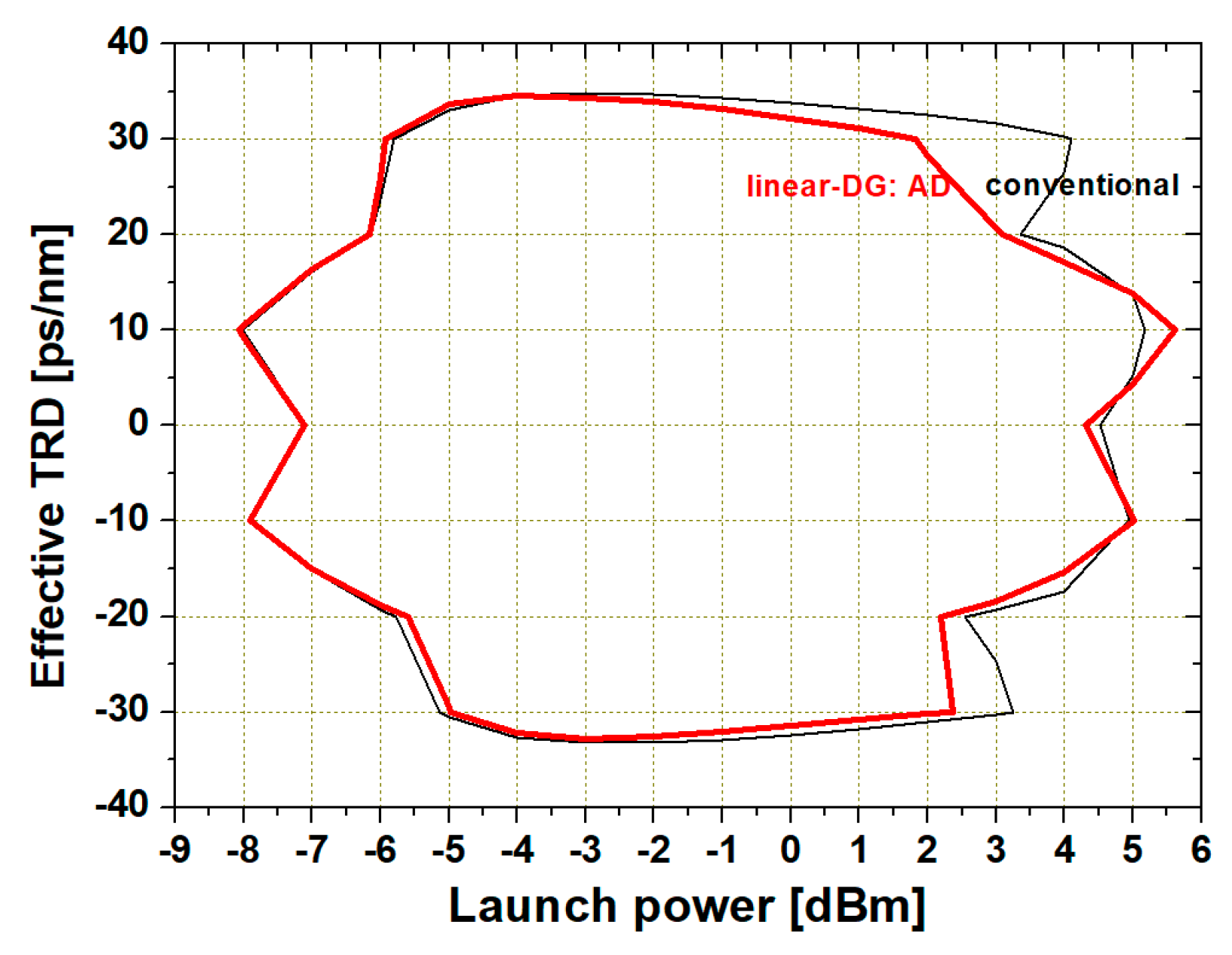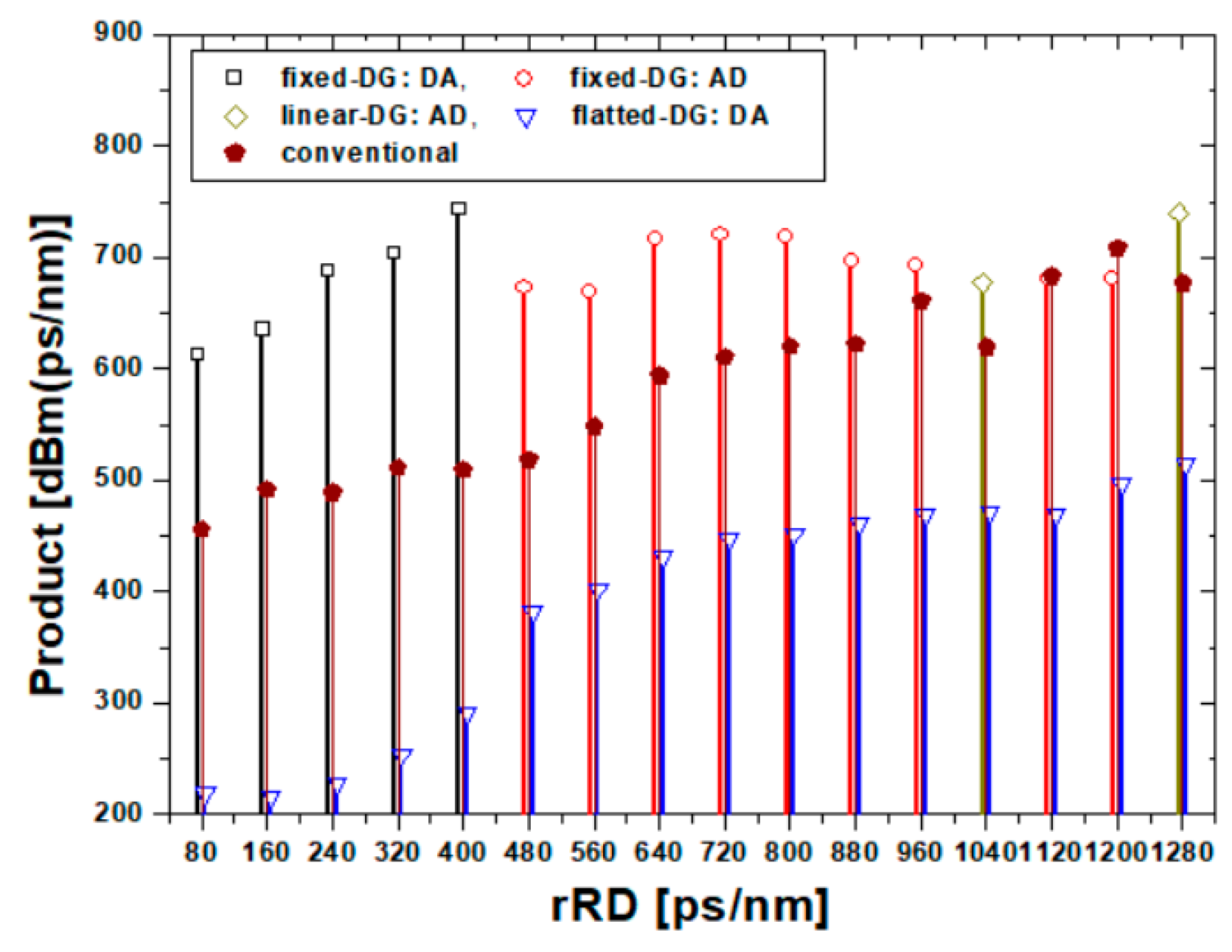2.1. Dispersion-Managed Link
Figure 1 shows the WDM system and dispersion-managed optical transmission link to be analyzed through simulation in this paper. OPC is located in the middle of the entire transmission link in
Figure 1. As will be mentioned later, the number of WDM channels transmitted over the link is 24, and the data rate of each channel is assumed to be 40 Gb/s.
Though dispersion management is achieved by DCF added to all fiber spans of the first and second half-links with respect to midway-OPC, the dispersion maps are designed so that the cumulative dispersion becomes 0 ps/nm repeatedly at intervals of the fiber span group (FSG) as shown in
Figure 2, rather than a structure in which the cumulative dispersion becomes 0 ps/nm for each fiber span. We divide these FSG spacings non-uniformly into 2, 4, 8, and 16 for each half-link. In other words, as shown in
Figure 2, the zero-crossing place of cumulative dispersion in each half-link is not constant. Also, as can be seen in
Figure 2, the dispersion maps are designed so that the zero-crossing places of cumulative dispersion in the first and the second half-link are symmetrical to each other with respect to midway-OPC. That is, if the zero-crossings of the cumulative dispersion occurs at the 2nd, 4th, 8th, and 16th fiber spans in the first half-link, then the zero-crossings in the second half-link must correspondingly occur in the order of 16th, 8th, 4th, and 2nd fiber spans. This dispersion map structure is hereafter referred to as the growth-decaying (GD) scheme, and in this paper, we simultaneously analyze the decaying-growth (DG) scheme, where the zero-crossing of the cumulative dispersion in each half-link is opposite to the GD scheme.
The dispersion map proposed in this study has another symmetry. This symmetry is made by the cumulative dispersion distribution of successive FSGs. When the cumulative dispersion of the first FSG increases linearly to the middle point and then decreases, the cumulative dispersion of the next FSG decreases and then increases with the same slope. Also, the cumulative dispersion profile of consecutive FSGs configured in this way is symmetrical about the midway-OPC. In this paper, this symmetry has two forms for all proposed dispersion maps. In order to distinguish these two types, we denote AD (ascent–descent) and DA (descent–ascent) according to the distribution shape of the cumulative dispersion in the first FSG, as shown in
Figure 2.
The last factor considered to analyze the effect of the proposed dispersion maps on WDM channel distortion compensation is the increase/decrease rate of dispersion accumulated in the FSGs. The increase and decrease in the accumulated dispersion depends on the magnitude and sign of the residual dispersion of each fiber span. As shown in
Figure 2, the cumulative dispersion reversal occurs at each intermediate position of all FSGs. And, as mentioned above, the number of fiber spans constituting the FSG in which zero-crossing of cumulative dispersion occurs is 2, 4, 8, and 16 in each half-link. Based on these features, the dispersion maps classified into the following four cases.
The first case is that the residual dispersion assigned to all fiber spans is assumed to be same for all FSGs. The dispersion maps shown in
Figure 2a,b correspond to the first case. Analyzing the dispersion map of
Figure 2a, the rate of increase/decrease in the cumulative dispersion in all FSGs is the same regardless of the number of the fiber spans each FSG has. That is, if the rate of the cumulative dispersion in an FSG consisting of two fiber spans is ±100 (ps/nm)/span, the increase/decrease rates of the cumulative dispersion in all other FSGs also have the same value. For this reason, we will call the dispersion map in
Figure 2a,b the ‘fixed’ scheme.
The remaining three cases are structures that determine the magnitude of the residual dispersion allocated to each fiber span in relation to the number of fiber spans of the four FSGs arranged in each half-link. More specifically, based on the magnitude of the residual dispersion allocated to one fiber span in the FSG with the smallest number of fiber spans (this is called ‘reference residual dispersion’ (abbreviated as ‘rRD’)), the magnitude of the residual dispersion allocated to each fiber span constituting the other three FSGs is obtained by artificially changing the rRD magnitude depending on the number of fiber spans of the corresponding FSG.
In the dispersion map shown in
Figure 2c, the residual dispersion magnitudes of each fiber span of the FSG with 4 fiber spans, with 8 fiber spans, and with 16 fiber spans in each half-link are obtained by multiplying the magnitude of the rRD by 2, 4, and 8 times, respectively. In this dispersion map, if the increase/decrease rate of cumulative dispersion in FSG with 2 fiber spans is ±100 (ps/nm)/span, then the increase/decrease rate of cumulative dispersion in FSGs with 4, 8, and 16 fiber spans has values of ±200 (ps/nm)/span, ±400 (ps/nm)/span and ±800 (ps/nm)/span, respectively. For this reason, we will call the dispersion map in
Figure 2c,d the ‘squared’ scheme. In the dispersion map shown in
Figure 2e,f, the residual dispersion magnitudes of each fiber span of the FSG with 4 fiber spans, with 8 fiber spans, and with 16 fiber spans in each half-link are obtained by multiplying the magnitude of the rRD by 2, 3, and 4 times, respectively. In this case, because the increase/decrease rate of the cumulative dispersion in each FSG is 2, 3, and 4 times of FSG with 2 fiber spans, respectively, these will be called to the ‘linear’ scheme.
The last dispersion map considered in this study is the ‘flatted’ scheme shown in
Figure 2g,h, because the maximum and minimum cumulative dispersion of each FSG are constant, unlike other dispersion maps. This dispersion map can be obtained by allocating the values corresponding to 1/2, 1/4, and 1/8 times of the magnitude of the rRD as the residual dispersion magnitude of each fiber span of FSGs with 4, 8, and 16 fiber spans, respectively.
In summary, there are 16 types of dispersion maps proposed in this paper for compensation of distorted WDM channel signals according to the detailed configuration methods described so far. For the convenience of analyzing the simulation results, we classify and express the 16 dispersion maps in
Figure 2 as “the variation rate of rRD for each FSG—the deployment pattern of zero-crossing places: shape of unit dispersion map”, for example, “fixed-DG: AD”, “linear-GD: AD”, “flatted-DG: DA”, etc.
The shape of the 16 dispersion maps shown in
Figure 2 is determined by appropriate selection of the lengths and dispersion coefficients of the SMF and DCF constituting the transmission link. In this paper, the length and the dispersion coefficient of SMF (
lSMF and
DSMF) are assumed to be 80 km and 17 ps/nm/km, respectively, and the dispersion coefficient of DCF (
DDCF) is assumed to be −100 ps/nm/km in all fiber spans. However, to adjust the cumulative dispersion and the shape of the specific dispersion map, only the DCF length of each fiber span (
lDCF) is varied by the equation below.
where
RD means the residual dispersion of each fiber span.
Other characteristics of SMF and DCF assumed in this paper are as follows: the attenuation coefficient of SMF is 0.2 dB/km, the nonlinear coefficient of SMF is 1.35 W−1km−1 at 1550 nm, the attenuation coefficient of DCF is 0.6 dB/km, and nonlinear coefficient of DCF is 5.06 W−1km−1 at 1550 nm.
In all 16 dispersion maps analyzed in this paper, the deployment order of SMF and DCF is opposite to each other with respect to the midway-OPC, as can be seen in the transmission link shown of
Figure 1. That is, all dispersion maps are obtained from a structure in which DCF is always placed before SMF in all fiber spans of the first half-link, whereas DCF is always placed after SMF in all fiber spans of the latter half-link. The most fundamental reason for reversing the arrangement order of each fiber is to further strengthen the symmetry of the dispersion profile with respect to the middle of the entire transmission link, which is the basic condition of applying optical phase conjugation into an optical link.
And this deployment of optical fibers is to help achieve another purpose. Xiao et al. have reported that the best compensation of a distorted optical signal in a pseudo-linear system over a dispersion-managed link is that the total residual dispersion (TRD) is not 0 ps/nm but near 0 ps/nm, and the authors’ previous studies have confirmed this result. All of the dispersion maps proposed in this study have a structure in which the overall dispersion profile is obtained by successive combinations of the unit dispersion profiles made by each of the four FSGs in each half-link. Since the cumulative dispersion of these four FSGs is 0 ps/nm, the TRD in the half-link also becomes 0 ps/nm, making it difficult to achieve the best compensation condition for the distorted WDM channel. Therefore, in the proposed dispersion-managed link of
Figure 1, the TRD should be set to a value other than 0 ps/nm by using any one fiber span. We make the first fiber span in the first half-link or the last fiber span in the second half-link play this role. To be more precise, the variation of the TRD in the overall link for searching the optimal dispersion is set by correspondingly adjusting only the DCF length of the first or last fiber span under the respective circumstances where the TRD in the second or first half-link is set to 0 ps/nm. We define the methods for adjusting the TRD only with the DCF lengths of the first and last fiber span as pre-DC (dispersion calibrator) and post-DC, respectively.
2.2. WDM Transmitters, Recivers and Midway-OPC
The WDM transmitters and receivers located at both ends of the link in
Figure 1 are based on intensity modulation (IM) and direct detection (DD), respectively. First, in each transmitter, data bits generated by 127 (=2
7−1) pseudo-random bit sequence (PRBS) intensity-modulate light from distributed feedback laser diode (DFB-LD) in modulator. The output electric field of intensity-modulated 127-bit signals is modeled in return-to-zero (RZ) format with 10-dB extinction ratio (ER) and duty cycle of 0.5. It is also assumed that these RZ pulses are frequency chirp-free. We assume that the center wavelength of each channel is 1550 nm to 1568.4 nm with 100 GHz (0.8 nm) spacing, based on ITU-T Recommendation G.694.1.
The signals of these 24 channels with different wavelengths are multiplexed in the AWG-MUX and propagate through the first half-link consisting of 30 fiber spans. The chromatic dispersion is somewhat compensated by the dispersion management applied to each fiber span, but distortion due to the interaction between the Kerr nonlinearity and the residual chromatic dispersion is unavoidable. The multiplexed signals distorted while propagating through the first half-link are converted into phase-conjugated signals at the midway-OPC and propagated through the remaining second half-link. The received signals can be restored similarly to the original signals, as the conjugated signals effectively experience the effects of the interaction of Kerr nonlinearity and chromatic dispersion in the second half-link.
Phase-conjugation in midway-OPC is generated through the process of four-wave mixing (FWM) of the input multiplexed signal and the pump light in a highly nonlinear dispersion-shifted fiber (HNL-DSF) as a nonlinear medium for phase-conjugation. The power and wavelength of the pump light for generating the phase-conjugated waves are assumed to be 18.5 dBm and 1549.75 nm, respectively. Consequently, each wavelength of the conjugated 24 channels in the midway-OPC is then arranged from 1549.5 nm to 1528.5 nm (−0.8 nm interval).
Each channel demultiplexed through DeMUX is finally received after optical and electrical processing based on the DD method. We assume that the receiver bandwidth is 0.65 times 40 Gb/s. The WDM receiver is comprised of an EDFA with a noise figure of 5 dB, optical filter, PIN diode as photodetector, pulse-shaping Butterworth filter, and decision circuit.
